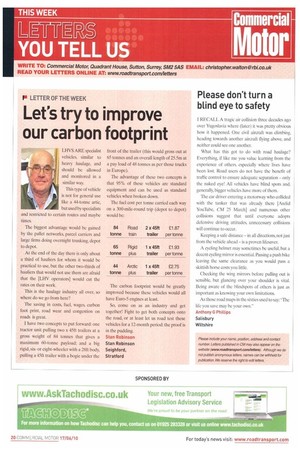Let's try to improve our carbon footprint
Page 20

If you've noticed an error in this article please click here to report it so we can fix it.
LHVS ARE specialist vehicles, similar to heavy haulage, and should be allowed and monitored in a similar way.
This type of vehicle is not for general use like a 44-tonne attic, but used by specialists and restricted to certain routes and maybe times.
The biggest advantage would be gained by the pallet networks, parcel carriers and large firms doing overnight trunking, depot to depot.
At the end of the day there is only about a third of hauliers for whom it would be practical to use, but the other two-thirds of hauliers that would not use them are afraid that the [LHV operators] would cut the rates on their work.
This is the haulage industry all over, so where do we go from here?
The saving in costs, fuel, wages, carbon foot print, road wear and congestion on roads is great.
I have two concepts to put forward: one tractor unit pulling two x 45ft trailers at a gross weight of 84 tonnes that gives a maximum 60-tonne payload; and a big rigid, sixor eight-wheeler with a 28ft body, pulling a 45ft trailer with a bogie under the front of the trailer (this would gross out at 65 tonnes and an overall length of 25.5m at a pay load of 48 tonnes as per those trucks in Europe).
The advantage of these two concepts is that 95% of these vehicles are standard equipment and can be used as standard vehicles when broken down.
The fuel cost per tonne carried each way on a 300-mile-round trip (depot to depot) would be: The carbon footprint would be greatly improved because these vehicles would all have Euro-5 engines at least.
So, come on as an industry and get together! Fight to get both concepts onto the road, or at least let us road test these vehicles for a 12-month period: the proof is in the pudding.
Stan Robinson Stan Robinson Seighford, Stratford
































































































































